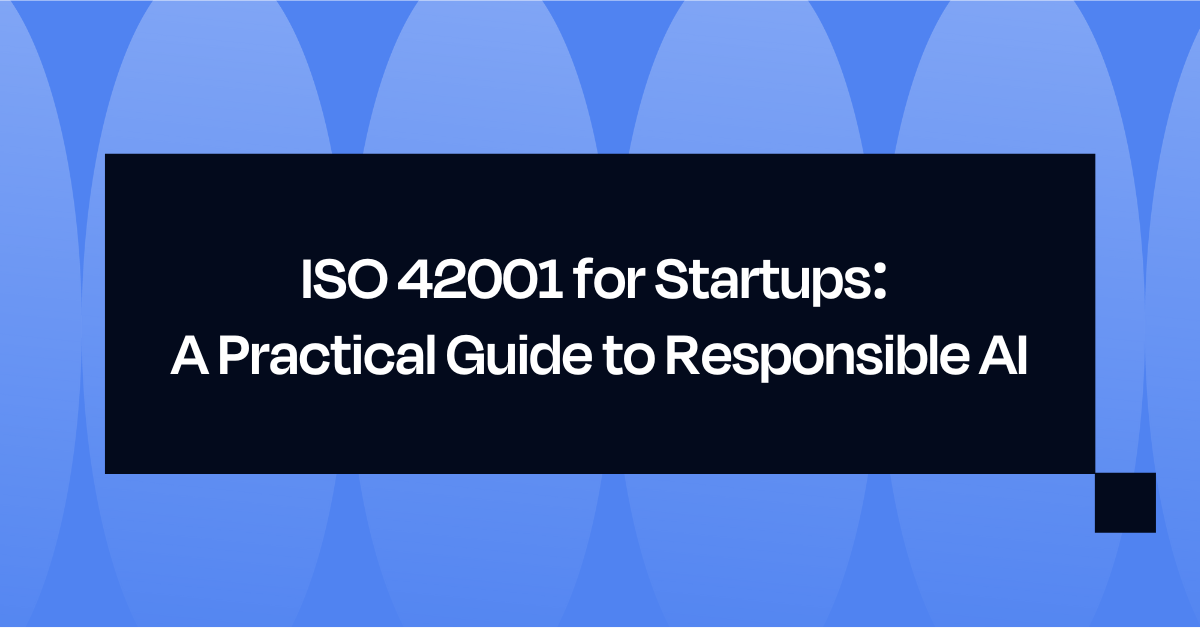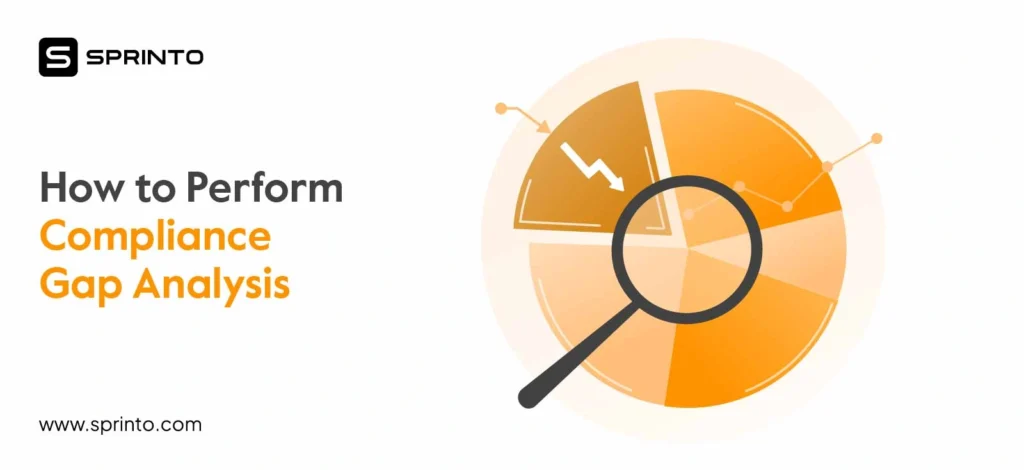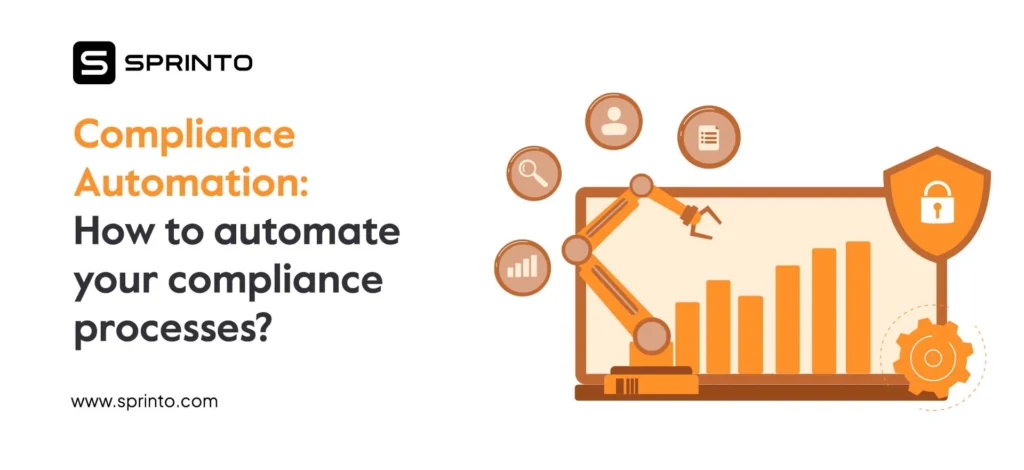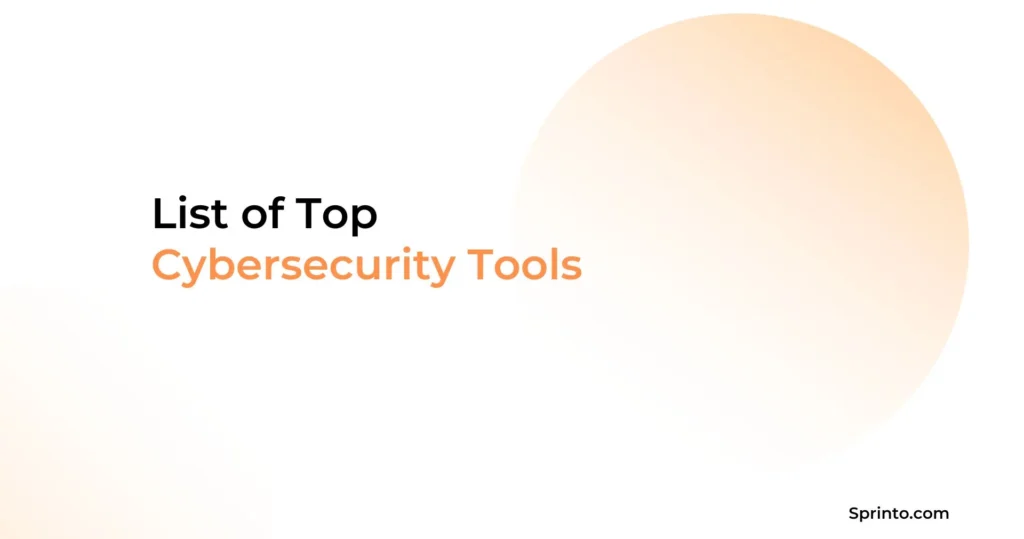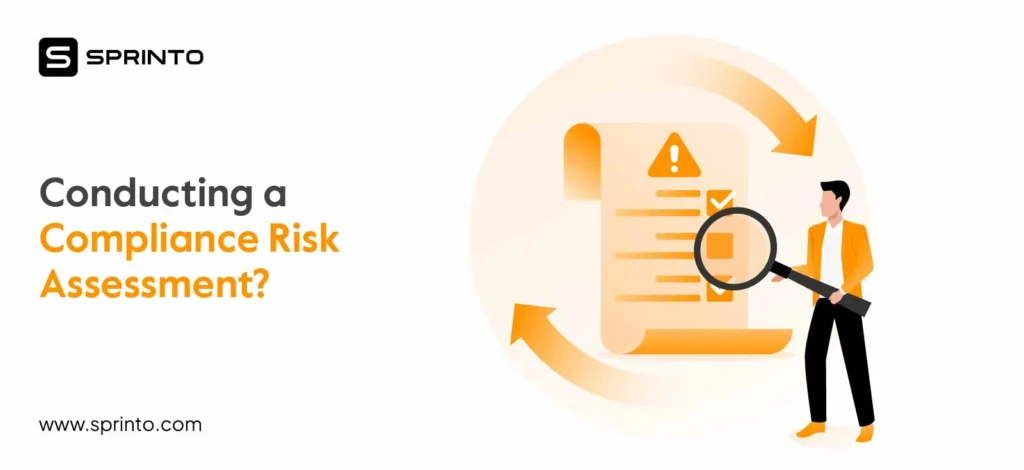Startups today face immense pressure to adopt AI and ship features quickly. But as AI becomes increasingly embedded in products and processes, the tension between speed and security grows. Enterprise buyers demand greater transparency and investors want to understand how bias, data privacy, and AI risk is managed.
This is where ISO 42001 comes in. As the first global standard for AI management, it offers startups a structured way to use AI responsibly, build trust with stakeholders, and stay ahead of emerging regulations. In this blog, we break down what ISO 42001 is, why it matters for startups, and how to approach it in a way that’s both practical and scalable.
TL;DR
| ISO 42001 helps startups prove responsible and ethical AI use, building trust with enterprise buyers, investors, and regulators while staying ahead of upcoming AI regulations. |
| The standard outlines how to govern AI through policies, risk assessments, training, documentation, and continuous improvement across clauses 4 to 10. |
| Certification usually costs between $4,000 and $25,000 and takes about 4 to 12 months, depending on team size, AI complexity, and compliance readiness. |
| The process includes defining scope, assessing gaps, building governance, training teams, conducting internal reviews, and completing external audits to earn certification. |
What is ISO 42001?
ISO 42001 is the world’s first AI-specific management system standard that defines how organizations must build, govern, and continuously improve AI systems. It helps startups ensure the correct, ethical, and responsible use of AI while covering areas such as fairness, transparency, accountability, and risk management.
This signals credibility to enterprise buyers, accelerates deal cycles, and future-proofs their stack against evolving AI regulations.
Why does ISO 42001 matter for startups?
More often than not, startups run on lean teams with AI stepping in to maximize efficiency. From automating internal workflows to powering core product features, AI is embedded across the stack.
But as AI becomes central to how startups operate and deliver value, questions around its adoption and management are increasingly becoming critical. Investors, enterprise customers, and regulators now expect proof of responsible AI use. This is where structured frameworks like ISO 42001 start to matter.
Adopting ISO 42001 early allows startups to proactively address compliance and trust concerns, rather than reacting to them later. It can streamline enterprise sales, strengthen investor confidence, and prepare teams for future regulatory shifts, such as the EU AI Act. In a fast-moving AI ecosystem, it offers a practical path to scale responsibly.
Key ISO 42001 requirements for startups
ISO 42001 sets out a management system for the responsible use of artificial intelligence. While the standard is designed to apply across organizations of all sizes, early-stage startups can adopt it in a way that aligns with their scale and operations. Below is a breakdown of the key clauses and what each means in the context of a startup.
Clause 4: Context of the organization
This clause requires organizations to understand the internal and external factors that influence their use of AI, identify relevant stakeholders, and define the scope of their AI management system.
What this means for startups:
Startups mustclearly map where and how AI is used within the business, identify who it impacts (such as customers, users, or regulators), and outline the legal, social, or operational factors that shape how AI is applied.
Clause 5: Leadership
This clause requires top management to demonstrate commitment to responsible AI use by establishing an AI policy and assigning roles and responsibilities within the organization.
What this means for startups:Startup leaders must play an active role in supporting AI governance. This includes issuing a clear AI policy and defining who is responsible for managing AI-related risks, even if those responsibilities are shared across small teams.
Clause 6: Planning
This clause requires organizations to assess risks and opportunities related to AI, establish objectives, and determine how those objectives will be achieved.
What this means for startups:
Startups must identify concrete risks that can emerge from their AI systems. These include biased or discriminatory outputs, inaccurate predictions due to poor or changing data (model drift), misuse of AI results by customers or employees, privacy breaches from mishandling training data, or non-compliance with upcoming regulations.
Based on these risks, startups should set practical goals such as, establishing fairness checks, maintaining minimum accuracy thresholds, documenting data sources, or ensuring explainability, and create simple action plans to manage and review these risks regularly.
Clause 7: Support
This clause requires organizations to provide the necessary resources, ensure staff competence, maintain awareness, and keep documented information current.
What this means for startups:
Startups should provide basic training to team members involved in AI development, highlighting the risks, responsibilities, and policies relevant to their role. They must set up simple, repeatable onboarding processes to maintain awareness as teams grow.
Basic documentation, such as AI usage guidelines, data handling protocols, and system design decisions, should be stored in a shared internal space and reviewed regularly to reflect current practices.
Clause 8: Operation
This clause requires organizations to plan, implement, and control processes related to the lifecycle of AI systems. It also covers data management, change control, and incident handling.
What this means for startups:
Startups must establish simple, repeatable processes for building, testing, deploying, and monitoring AI systems. For example, teams must maintain a log of changes to document model updates, use version control for datasets, and define basic criteria for model validation before deployment.
They should also set up an incident response workflow that outlines what to do when the AI system produces harmful, incorrect, or unexpected outcomes.
Clause 9: Performance evaluation
This clause requires organizations to evaluate the performance of their AI management system through monitoring, internal audits, and management reviews.
What this means for startups:
Startups should define a few meaningful metrics to track AI performance, conduct regular check-ins to review outcomes, and gather feedback from internal or external stakeholders to drive improvements.
Clause 10: Improvement
This clause requires organizations to address nonconformities, take corrective actions, and continually improve the AI management system.
What this means for startups:
Startups should be ready to learn from issues that arise. This includes documenting what went wrong, taking steps to resolve it, and using those insights to refine processes, policies, or controls over time.
Policies, risk logs, change control, and audits—all in one place.
👉 See Sprinto in action →
ISO 42001 certification for startups: Costs and timelines
Getting ISO 42001 certified is a strategic investment in building trust and operational discipline around AI. For startups, it can unlock enterprise deals, reduce regulatory friction, and create internal clarity on how AI is built and governed. Here’s what the certification journey looks like.
Estimated cost for startups
For startups, certification costs vary depending on the size of the team, the complexity of AI systems, and the level of external support involved. They can range anywhere from $4000 to $25000, including the audit fee, implementation and preparation costs, and tooling costs. Automation can help with savings when used well.
Timeline to certification
The average certification journey takes 4 to 12 months, depending on several factors:
- 4–6 months for startups with prior experience in compliance (e.g., SOC 2 or ISO 27001)
- 6–12 months for startups starting from scratch or with complex AI implementations
Key steps in the ISO 42001 certification process
Achieving ISO 42001 certification involves a series of structured steps that ensure your AI management system meets global standards. Here’s a breakdown of the key stages in the certification journey:
1. Define scope
Start by deciding which AI systems and teams will be included in the ISO 42001 certification. To manage the implementation effort, it is often best to focus on one product area or use case. Document the defined scope clearly, as it will guide your policies, risk assessments, and audit preparation.
2. Understand requirements
Review Clauses 4 to 10 of ISO 42001 to understand what the standard expects from your organization. Assign internal ownership for each clause to ensure clear responsibility and accountability. Use guidance documents, expert support, or tools that translate the standard into startup-relevant actions.
3. Conduct gap assessment
Compare your current practices against ISO 42001 requirements to identify areas that need improvement. Based on this gap analysis, create a prioritized checklist of missing policies, workflows, or controls. Use the findings to build a focused and achievable implementation plan.
4. Build governance
Start with the minimum required structure to meet audit expectations without introducing unnecessary overhead. Develop essential policies, risk logs, checklists, and process documentation tailored to your team’s operations. Store all governance materials in a centralized workspace so they are easy to access and maintain.
5. Train your team
Ensure everyone involved in building or managing AI systems understands their responsibilities under ISO 42001. Conduct short, targeted training sessions based on team roles and their involvement in AI workflows. Keep a record of completed training sessions, which will be helpful during the audit.
6. Conduct an internal review
Before engaging an auditor, perform an internal review to test your documentation and operational readiness. Simulate common AI failure scenarios or data issues to validate your risk and incident response workflows. Involve leadership in this review to ensure team alignment and readiness for external scrutiny.
7. Schedule the audit
Choose a recognized certification body to carry out the two-stage audit process. Prepare your team for what to expect, and organize all required documentation and evidence in advance. During the audit, respond promptly to auditor questions and address any gaps identified.
8. Close gaps and get certified
Audits are seldom perfect but what instills confidence is prompt action. Once the auditor identifies any nonconformities, take corrective actions and provide follow-up evidence. Once all issues are resolved, the auditor will issue the ISO 42001 certification, valid for three years. Plan for annual surveillance audits and set up internal reminders to maintain continuous compliance.
Automate audits, policy tracking, and governance with Sprinto’s ISO 42001-ready platform built for fast-moving AI teams.
👉 Book a demo →
Benefits of ISO 42001 for startups
While ISO 42001 is a governance standard, its impact extends beyond compliance. For startups, it can drive trust, efficiency, and readiness across multiple fronts. Here are some of the key benefits:
1. Signals credibility
ISO 42001 certification shows that your startup follows responsible and transparent AI practices. This credibility simplifies security reviews, builds enterprise trust, accelerates due diligence, and strengthens your positioning in regulated or AI-sensitive markets.
2. Strengthen AI systems
The framework promotes clear ownership, documented workflows, and ongoing monitoring. This improves system reliability, reduces unexpected failures, and helps teams resolve issues faster.
3. Align with emerging AI regulations
With regulatory frameworks like the EU AI Act and U.S. policy developments on the rise, ISO 42001 helps startups prepare in advance. It reduces the cost and disruption of compliance later by putting core guardrails in place from the start.
4. Improve internal alignment
ISO 42001 encourages teams to align on AI design, deployment, and monitoring. This reduces cross-functional friction and ensures product, engineering, and leadership teams operate with a shared understanding of risk and responsibility.
Challenges that startups face with ISO 42001
While ISO 42001 brings long-term value, startups often face practical hurdles when trying to implement it. Below are common challenges, along with ways to address them early.
1. Limited bandwidth and expertise
Most startups do not have dedicated compliance or AI governance teams. The responsibility often falls on engineering or product leaders, who are already managing delivery deadlines.
How to solve it: Start small by assigning shared ownership across existing roles. Leverage lightweight frameworks and engage external advisors or fractional experts who can help interpret the standard in startup terms.
2. Interpreting requirements
Because ISO 42001 is broad and designed for organizations of all sizes, it can be difficult for startups to know how much is “enough.” This can lead to over-complication or gaps in coverage.
How to solve it: Focus on the intent behind each clause rather than perfection. Use practical checklists, start with basic documentation, and iterate as you scale. Refer to examples from similar companies where possible.
3. Balancing speed with structure
Startups are built for rapid iteration, but ISO 42001 introduces structure through policies, reviews, and documentation. This can feel at odds with how product teams operate.
How to solve it: Embed AI governance into existing development workflows rather than creating parallel processes. Use tools that integrate with your current stack (e.g. GitHub, Jira, Notion) to reduce friction.
4. Managing oversight
ISO 42001 requires ongoing monitoring of AI systems, including changes to models, data, and performance. Manually monitoring these can be difficult in a fast-paced environment.
How to solve it: Automate wherever possible. Track key metrics using version control, monitoring scripts, and alerts. Consider a compliance automation platform that supports continuous control monitoring.
5. Lack of guidance
As a newer standard, ISO 42001 lacks the abundance of templates and tooling that more mature frameworks offer. This adds to the learning curve and setup time.
How to solve it: Start with foundational templates (risk registers, AI policies, change logs) and adapt them over time. Monitor updates to the standard and emerging resources from compliance providers or working groups.
Embed approvals, logs, and alerts into GitHub/Jira/Notion workflows.
👉 Get a walkthrough →
Expedite ISO 42001 compliance with Sprinto
As an ISO 42001 certified company ourselves, we understand the process firsthand. From initial planning to audit preparation, our platform and support model are shaped by direct experience with what it takes to meet the standard effectively.
Sprinto simplifies ISO 42001 implementation for startups by turning a complex, clause-heavy standard into a clear, structured, and audit-ready program. Here’s how Sprinto supports your ISO 42001 journey:
- Mapped controls: Map each ISO 42001 requirement to workflows, controls, and evidence collection within the Sprinto platform.
- Out-of-box policy templates: Use pre-built policies, risk logs, and governance templates tailored for AI-first teams.
- Automation where it matters: Monitor compliance continuously and collect evidence automatically from your systems.
- Expert-led implementation: Work with certified compliance experts who guide you from setup to audit.
- Faster, cleaner audits: Organize all documentation in one place and coordinate directly with auditors to avoid unnecessary delays.
Kickstart your ISO 42001 journey with Sprinto. Speak to our experts.
FAQs
No, ISO 42001 is not mandatory. However, regulators, enterprise customers, and investors look for assurance that AI systems are built and managed responsibly. ISO 42001 builds that trust, and adopting it early can help startups stay ahead of regulatory and market expectations.
For early-stage startups, total costs (including audits, preparation, and internal efforts) typically range from $4,000 to $25,000, depending on factors such as size, complexity and whether external consultants or platforms are used.
Depending on your readiness and scope, certification can take 4 to 12 months. Faster executions (3–5 months) are possible for startups with simpler AI use cases and better security maturity.
Yes, startups can self-implement ISO 42001. However, doing so requires a solid understanding of the standard and internal commitment across teams. Many startups choose to work with automation platforms to accelerate implementation, reduce risk, and ensure audit readiness.
ISO 42001 applies to any AI system that influences decision-making, user outcomes, or operational processes. This includes machine learning models, recommendation engines, chatbots, and other automated systems, regardless of whether AI is the product or part of the internal stack.
Payal Wadhwa
Payal is your friendly neighborhood compliance whiz who is also ISC2 certified! She turns perplexing compliance lingo into actionable advice about keeping your digital business safe and savvy. When she isn’t saving virtual worlds, she’s penning down poetic musings or lighting up local open mics. Cyber savvy by day, poet by night!
Explore more
research & insights curated to help you earn a seat at the table.



